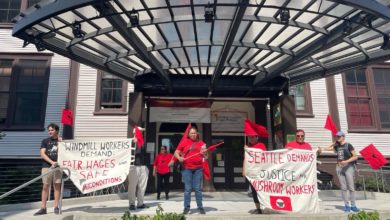Most people in the U.S. have been submerged in the media bath of coverage on the deadly landslide event in Oso, Wash. that occurred March 22. News reports have highlighted both the tragic loss of life as well as the heroic efforts of rescuers, first to try to save lives and now to find and identify bodies. As of March 30, the Snohomish County Medical Examiner’s office has confirmed that 18 of the dead have been identified, a further nine or 10 bodies have not been formally identified, and 30 people remain missing or unaccounted for as a result of the landslide. While landslides are natural events, this tragedy was not simply caused by nature; the drive for profit motivated a series of decisions that allowed this tragedy to occur.
The particular hillside that slid across the Stillaguamish River in an event resembling a small tsunami has been variously called the Hazel Slide area and the Steelhead Haven Slide area. The slide hazard here has been well studied over the last 20 years. There have been several technical reportsndocumenting in some detail the geological processes involved in the persistent slide hazard along this stretch of the Stillaguamish River, one by Daniel Miller and two by Tracy Drury, available here and here.
Geologists warned of danger
According to the research, the hillside on the north side of this bend of the Stillaguamish River is inherently unstable because the composition of the soil is based on loose gravel and sandy silt deposits combined with the bend in the river. The average level of the river undercuts the bend, called a “toe” and the cliff eventually overhangs the water below. In cases when there is a period of heavy rains preceded by a relative dry spell, the soil becomes saturated like a sponge. The difference is that a sponge has an inherent internal structure, whereas the sandy, gravelly silt deposits will collapse into a mile-long muddy puddle spilling out across the river. This process has occurred at an average frequency of once every 10 years for at least the last 80 years.
Research has detailed how clear-cutting a hillside will increase the frequency and the size of the slides because the trees absorb and hold large quantities of the water. Additionally, the tree covering adds a 10-foot deep layer of stability to the surface of the hillside. However, the presence of trees does not stop the eventuality of landslides, it merely decreases the frequency and severity of the landslides. The Oso slide area is inherently unstable.
Researchers had suggested ways to limit the river’s ability to undercut of the hillsides “toe” at the river bend, as a way to diminish the frequency and severity of the inevitable landslides and have stated that the long term clear-cutting of the hillside make efforts to alleviate landslide danger much more difficult. One researcher, Dr. Daniel Miller said, “Frankly, I was shocked that the county permitted any building across from the river,” referring to the neighborhood destroyed by the current landslide. (Seattle Times, March 24)
Thus we can see that the loss of life and property in the Oso landslide in the Hazel (Steelhead) slide is directly attributable to the greed and ambition of timber companies and housing developers who built in the slide zone despite the clear warnings from scientists of the danger.
Workers demonstrate selfless heroism, give lie to capitalist myth of self-interest
This disaster also presents an opportunity to attack some of the dominant themes of the capitalist theory of reality.
One of the basic premises of the capitalist narrative is that the only way to motivate people is through raw unfettered self-interest at the expense of others. Yet this myth of capitalism is contradicted by the fact that neighbors of the victims in the landslide area have been risking arrest to dig through the quicksand in an effort to rescue and recover victims of the landslide, not to mention the heroic efforts of rescue personnel and volunteers, some of whom had to be towed to safety from the quicksand. This clearly demonstrates that workers can be motivated by factors other than raw greed and self-interest.
The competitive nature of capitalism is clearly to blame for the loss of life in this disaster. Everybody knew that this particular bend of the Stillaguamish River was in the direct path of the Hazel Slide. The drive for short-term gain led to the hillside being clear-cut by the big money logging investors. Why did the logging company chop down all of the trees over the last 60 years? Because they had to show a profit on the next quarter’s earning statement.
The system is to blame
Why did the developers build new homes in that neighborhood? To show a quick profit by selling homes to people who wanted cheaper housing in a stunning rural setting with good fishing. There was available land at a cheap price and the developers were willing to ignore any seemingly distant risk of a landslide for the prospect of showing a profit on next quarter’s earning statement. The residents were willing to believe that the developers knew what they were doing and purchased houses in an idyllic setting. Tragically, instead of a paradise, some suffered a hellish death being suffocated and literally ground up by a tsunami of mud.
Imagine a society not run by the whip of next quarter’s earning statement. Imagine instead a planned economy run for the benefit of all of society’s working people. No one would be trying to make profit by building housing in a known slide area or by clear-cutting a hillside with a known slide hazard pointing directly at a residential neighborhood. Further, once a slide hazard had been proven to exist, in a socialist system, residents would have been relocated to a safer location, and perhaps this particular bend of the Stillaguamish River turned into a game preserve.
We hold the capitalist system directly responsible for putting houses and people directly in the path of the Oso mudslide disaster. Market forces motivate developers to building housing where the profits are greatest in order to produce capital to invest in further development projects, rather than building houses in the safest, most sensible locations. It is not simply a matter of unscrupulous people, although such people do exist. The point is that the system puts market forces into play that compel those with economic power to make choices that maximize profits in the short term rather than choices that will benefit people, society and the future of the planet, in the long run.






